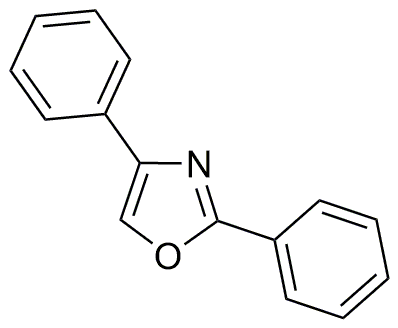2,4-Diphenyloxazole is widely utilized in research focused on:
- Fluorescent Detection: This compound is commonly used as a fluorescent dye in various analytical techniques, enhancing the visibility of biological samples under UV light.
- Radiation Detection: It serves as a key component in scintillation counters, which are essential for detecting ionizing radiation in nuclear and medical applications.
- Polymer Science: In the development of advanced materials, 2,4-Diphenyloxazole is incorporated into polymers to improve their optical properties, making them suitable for use in photonic devices.
- Biological Research: The compound is utilized in the study of cellular processes, particularly in assays that require sensitive detection of biomolecules, aiding in drug discovery and development.
- Environmental Monitoring: It is applied in the detection of pollutants, providing researchers with a reliable method for assessing environmental contamination levels.
General Information
Properties
Safety and Regulations
Applications
2,4-Diphenyloxazole is widely utilized in research focused on:
- Fluorescent Detection: This compound is commonly used as a fluorescent dye in various analytical techniques, enhancing the visibility of biological samples under UV light.
- Radiation Detection: It serves as a key component in scintillation counters, which are essential for detecting ionizing radiation in nuclear and medical applications.
- Polymer Science: In the development of advanced materials, 2,4-Diphenyloxazole is incorporated into polymers to improve their optical properties, making them suitable for use in photonic devices.
- Biological Research: The compound is utilized in the study of cellular processes, particularly in assays that require sensitive detection of biomolecules, aiding in drug discovery and development.
- Environmental Monitoring: It is applied in the detection of pollutants, providing researchers with a reliable method for assessing environmental contamination levels.
Documents
Safety Data Sheets (SDS)
The SDS provides comprehensive safety information on handling, storage, and disposal of the product.
Product Specification (PS)
The PS provides a comprehensive breakdown of the product’s properties, including chemical composition, physical state, purity, and storage requirements. It also details acceptable quality ranges and the product's intended applications.
Certificates of Analysis (COA)
Search for Certificates of Analysis (COA) by entering the products Lot Number. Lot and Batch Numbers can be found on a product’s label following the words ‘Lot’ or ‘Batch’.
*Catalog Number
*Lot Number
Certificates Of Origin (COO)
This COO confirms the country where the product was manufactured, and also details the materials and components used in it and whether it is derived from natural, synthetic, or other specific sources. This certificate may be required for customs, trade, and regulatory compliance.
*Catalog Number
*Lot Number
Safety Data Sheets (SDS)
The SDS provides comprehensive safety information on handling, storage, and disposal of the product.
DownloadProduct Specification (PS)
The PS provides a comprehensive breakdown of the product’s properties, including chemical composition, physical state, purity, and storage requirements. It also details acceptable quality ranges and the product's intended applications.
DownloadCertificates of Analysis (COA)
Search for Certificates of Analysis (COA) by entering the products Lot Number. Lot and Batch Numbers can be found on a product’s label following the words ‘Lot’ or ‘Batch’.
*Catalog Number
*Lot Number
Certificates Of Origin (COO)
This COO confirms the country where the product was manufactured, and also details the materials and components used in it and whether it is derived from natural, synthetic, or other specific sources. This certificate may be required for customs, trade, and regulatory compliance.


